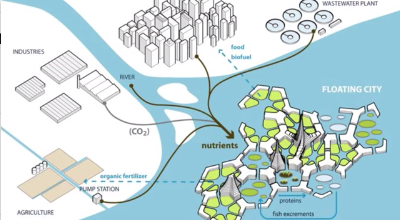Pollution is nothing but the resources we are not harvesting. We allow them to disperse because we’ve been ignorant of their value.
Buckminster Fuller
World Water Day (March 22) and Earth Day (April 22) promote activities that often focus on getting people to change their behavior because the organizers start with the perspective that the needs and wants of people are in conflict with the needs of a healthy environment.
For cities based on land, that is often true.
Karina Czapiewska of Blue21 (formerly DeltaSync) says in Seasteading:How Floating Nations Will Restore the Environment, Enrich the Poor, Cure the Sick, and Liberate Humanity from Politicians that cities on land “extract water, nutrients, and fertile soil from the environment, but they don’t give anything back,” In other words, they behave like parasites.
One of the 8 Great Moral Imperatives of Seasteading is to Live in Balance with Nature, and in order to do that, cities must stop functioning as parasites and start functioning as symbionts.
“Symbiosis allows you to close the circle,” says Karina, “so you capture the nutrients and wastewater, and you just reuse it in a land city. It’s not one solution but an interlacing of all solutions that reinforce each other and create synergy.”
Seasteading activities like algae and seaweed cultivation produce food and fuel more efficiently than land-based activities. On a seastead, pollutants become resources. Food and energy production operate in symbiotic, closed-loop systems. Floating structures provide protection and stability for coral to grow and fish to congregate.
It may even be possible to extract CO2 from the atmosphere to support aquaculture, which reduces the acidification and rising temperatures of the ocean. Algae transform the carbon pollution dumped into the ocean into edible sea crops. Algae pulls carbon from the ocean and the ocean pulls carbon from the air.
This year, instead of trying to change human behavior, help us spread the word about seasteading– so that we can build communities that float, where human needs can align with restoring the environment.
Please donate to Restore the Environment with Seasteading on our website or via PayPal.

